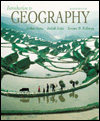 |  Introduction to Geography, 8/e Arthur Getis,
San Diego State University
Judith Getis
Jerome D. Fellmann,
University of Illinois, Urbana-Champaign
Physical Geography: Landforms
Objectives:After reading and studying this chapter you should be able to:
1.
Understand geologic time and the processes associated with it.
|
 |  |  | 2.
Distinguish among the three types of forces that interact to produce landforms and to associate the major
landforms with each process.
|
 |  |  | 3.
Differentiate between divergent, transform, and convergent boundaries and understand the features associated with these boundaries.
|
 |  |  | 4.
Identify the structure of the earth and how it relates to the theory of continental drift.
|
 |  |  | 5.
Distinguish among the properties of the three types of rock and how they are formed.
|
 |  |  | 6.
Identify the primary tectonic forces and the kinds of landforms which are associated with them.
|
 |  |  | 7.
Understand the difference between mechanical and chemical weathering.
|
 |  |  | 8.
Understand the differences between major gradational processes and the landforms each produces.
|
 |  |  | 9.
Distinguish between the effects of running water in humid and arid areas and the difference between groundwater and surface water erosion.
|
 |  |  | 10.
Understand how and why glaciers form and the unique types of landforms they leave behind.
|
 |  |  | 11.
Understand coastal processes and the landform features produced by them.
|
 |  |  | 12.
Understand the affects agents of erosion and deposition.
|
 |  |  | 13.
Identify and locate major landform regions of the world.
|
|



 2002 McGraw-Hill Higher Education
2002 McGraw-Hill Higher Education